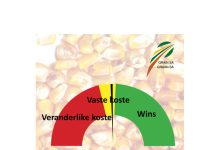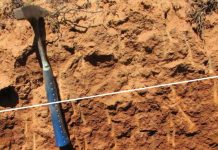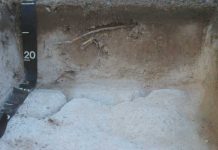Soil degradation (deterioration of soil properties) is one of the most important aspects that influence global food security. Sustainable agriculture focuses, inter alia, on the protection of the ability of soil to continually support plant growth. This article focuses on wind erosion and forms part of a series that highlights this resource.
Wind erosion is of major importance for almost every grain producer, especially those in the Western Free State and North West Province. The process of how it begins and how the soil particles are transported, is very interesting. In order to limit wind erosion, one must thoroughly understand the process of erosion and keep the factors that influence it in mind.
How does wind erosion take place?
Wind erosion is the process through which soil particles are loosened, transported and deposited elsewhere. The loosening process is fundamental to the start of the wind erosion process. It begins when the speed of the wind is such that the friction it causes is high enough to loosen the first soil particles. This usually happens at a wind speed of between 20,7 km/h and 48,6 km/h, depending on the condition of the soil surface.
At this point, a very interesting phenomenon takes place. Soil particles with a diameter of 0,05 to 0,5 mm and especially those in the category of 0,1 to 0,15 mm, begin to vibrate and, at a given moment, the soil particle leaps almost vertically into the air at an angle of between 75o and 90o (Figure 1).

The majority of the soil particles leap about 50 mm into the air and only a few leap higher than 300 mm. The wind then blows the particle away, between seven and ten times the height leapt, and the particle lands back on the surface at an angle of between 6o and 12o. The wind speed increases drastically between the soil surface and about 100 mm above the soil surface, from 0 km/h between the soil particles (regardless of the wind speed above the ground) to the given wind speed, which is usually measured at a height of 10 m.
The wind speed above the soil particle is thus always higher above than below the particle and this results in the particle starting to spin at between 200 and 1 000 revolutions per minute (rpm). When this spinning soil particle makes contact with other particles on landing, it then loosens the other particles, and this process snowballs until the entire piece of land is full of leaping soil particles.
Soil particles larger than 1 mm in diameter are seldom moved by wind, as they are too heavy. The particles of between 0,5 and 1 mm in diameter are also not picked up by the wind, but are bumped forwards by the other moving particles. This is known as surface creeping. Soil particles smaller in diameter than 0,05 mm, which are loosened by the leaping particles are swept high into the air by the wind streams and are held in suspension in the air. It is this form of wind erosion which gives rise to the spectacular windstorms (Figure 2). Via these wind streams, the soil particles are transported for hundreds of kilometres where they are then deposited when the wind speed decreases.
These soil particles are of major importance for us as agriculturalists, as the fertility of the soil is linked precisely to these particles. A substantial amount of these soil particles remain in suspension in the air until they fall with the rain. This gives rise to the breath-taking red sunsets from August to October.

Factors that influence wind erosion
Strong winds alone do not necessarily cause wind erosion. Other factors which contribute to wind erosion are, inter alia, the resistance of the soil to wind erosion, soil texture, surface coarseness, rainfall, length of the exposed surface and covering by plant matter. The most important factor that makes soil resistant to wind erosion, is the mass (size) of the individual grains of soil on the surface of the soil. If the soil particle or clod (aggregate) is heavy enough, it will not be moved by the wind.
These aggregates also protect other smaller soil particles and further reduce the wind speed directly on the soil surface. Aggregate stability is of particular importance in controlling wind erosion. Aggregates made mechanically through tilling, are usually an effective temporary control measure against wind erosion, but are mostly not stable against falling raindrops.
The aggregates “dissolve” during a high intensity rain shower, which makes the soil surface smooth and fine, leaving it susceptible to wind erosion. The addition of organic material to the soil is by far the most sustainable solution for wind erosion problems. This is because organic material serves as a source of nutrition for soil microbes and the microbes, in turn, secrete glues (polysaccharides) which are not water soluble. These glues stick the soil particles to each other and, in this way, form water stable aggregates.
Rain helps a lot to reduce wind erosion, but only for a short while as only a very thin layer of dry soil is needed to start soil erosion, even though the soil directly underneath is sopping wet. Wind erosion can begin again in a sandy soil within 20 minutes after a shower of rain. On the other hand, an intense shower of rain helps wind erosion by smoothing the surface and “dissolving” the clods.
The larger and longer the exposed land lies in the prevailing wind direction, the greater the danger of erosion. It is the leaping particles in particular which “infect” the entire piece of land and if there is a protective strip, it blocks the leaping particles. A headland covered with grass is often effective for this purpose. Plant material on the soil surface or growing plants are of particular importance in limiting wind erosion. It drastically lowers the wind speed at surface level so that wind erosion cannot begin.
Detrimental consequences of wind erosion
Soil losses
In the USA soil losses of up to 700 tons/ha/year have been measured. Losses of 100 tons/ha/year on erosion vulnerable soils are common. If one accepts that the fertile upper soil layer is 270 mm thick in most lands, at a rate of 100 tons/ha/year, this upper layer will be blown away in its entirety in 43 years. This damage can therefore take place in one producer’s lifetime on the farm.
This reduction in soil depth is, in fact, a slow process and that is why no one notices it. It is further disguised as the majority of producers plough their lands to the same depth every year. This simply means that should 5 mm of the topsoil be blown away during the year, during the next year 5 mm of the subsoil will be added to the topsoil and mixed in through ploughing.
This aspect may especially be observed when bits of bright yellow or red subsoil are visible on freshly ploughed lands. These bright colours from the subsoil indicate that there is virtually no organic material in that soil. This leads to water unstable clods that “dissolve” with intense falls of rain and contribute further to wind erosion. The decrease from the original land surface can also be observed when the eroded soil level is compared to a reference point such as a fence or headland, for example.
Changes in texture
When wind erosion takes place, it is the finer sand fraction that blows away. The coarser fraction remains behind and, with time, the soil becomes sandier and therefore more sensitive to wind erosion. The water retention ability of sandy soil is also lower than that of loam and that has a further negative impact on crop production.
Loss of soil fertility
Clay and organic material are the bases of soil fertility as plant nutrients are adsorbed on the exchange complex. It is this fraction in particular that blows away during dust storms. Valuable plant nutrients such as calcium, magnesium, potassium, sulphur and nitrogen are lost in this way. Through this, the plant nutrient status and its ability to retain plant nutrients is permanently degraded; and therefore also for all the following generations who have to produce crops on this land.
Crop damage
A young crop on a land can be blown to death within an hour during a dust storm. The damage is caused by the leaping soil particles when they are blown against the plants. The damage is worsened due to the fact that the particles spin at more than 200 rpm. These particles mostly have sharp edges and points which have a cutting action on the plants. Just imagine how sore it would be to a person standing with bare legs in such a tract of land.
Air pollution
Air pollution due to dust storms causes inconvenience for many people in that it causes dust to settle in the houses and certain people are allergic to it. Motor vehicle accidents also take place on roads due to poor visibility caused by dust storms. Wind erosion is therefore also socially unacceptable to the community.
Recommendations for the control of wind erosion
The methods of fighting erosion lie within the following principles:
- Reduce the wind speed at ground surface to below the threshold value at which wind erosion is initiated. Plant residues or upright plants on the land can make a major contribution here. Plough directly crossing the ambient wind direction. This firstly reduces the wind speed and secondly creates hollows in which the moving sand particles may be caught up.
- Reduce the soil’s susceptibility to wind erosion. This may be done by leaving the soil surface in a cloddy condition by using mechanical means. A more permanent solution is to leave large quantities of organic material on the land. Through this, the amount of organic material in the upper 50 mm of the soil will increase with time. This may be done by reduced tilling methods or no-till. Grass ley systems can also make a significant contribution here.
- In areas where wind erosion is especially a major problem, windbreaks may be planted. The distance between windbreaks should not be more than 20 times the height of the windbreak.
Summary
In the north-western grain areas, the majority of the cash crop lands are susceptible to wind erosion.
The sandy soils of the Western Free State are particularly susceptible to wind erosion.
Wind erosion damage on a particular tract of land often does not seem all that serious, but taken over a period of a few years however, the damage is major. Producers often stare themselves blind against the cost of control measures, but that is small change compared with the damage it eventually leads to. Wind erosion should be effectively controlled at all times.
For further information, please contact the authors at:
Martiens du Plessis: martiens@nwk.co.za
Prof Cornie van Huyssteen: vanhuyssteencw@ufs.ac.za
REFERENCES
Allison, FE. 1973. Soil organic material and its role in crop production. Elsevier Scientific Publishing Company: New York.
Brady, NC. 1990. The nature and properties of soils. 10th ed. Macmillan Publishing Company: New York.
Troeh, FR, Hobbs, JA & Donahue, RL. 1980. Soil and Water Conservation for Productivity and Environmental Protection. Prentice Hall, Englewood Cliffs: New Jersey.
Van der Walt, HVH & Van Rooyen, TH. 1990. A glossary of soil science. The Soil Science Society of South Africa: Pretoria.


















